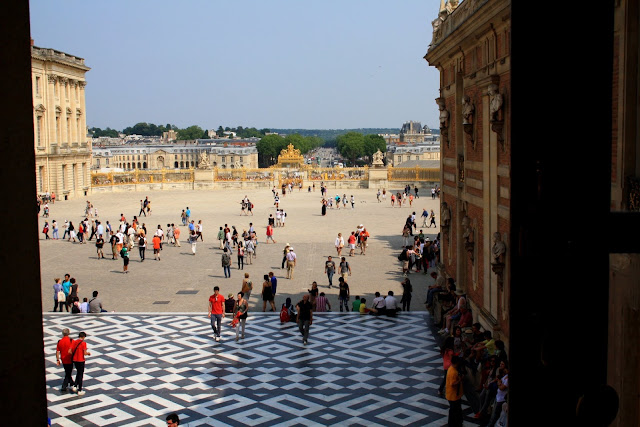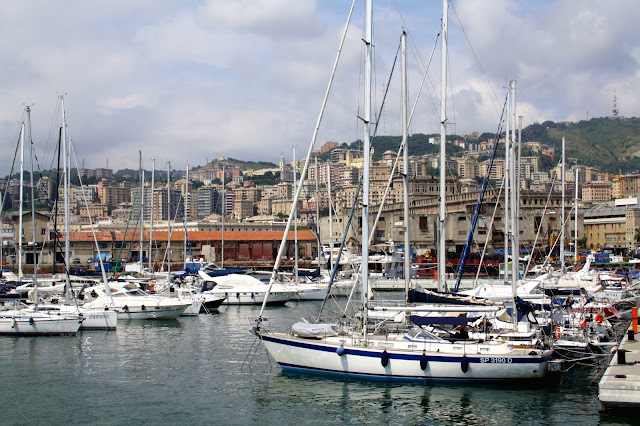Wersal "ma w sobie coś królewskiego i zniewieściałego" - Percy Shelley/ Versailles has "something effeminate and royal" - Percy Shelley
Percy Shelley wraz z Mary Shelley i Claire Clairmont odwiedzili Wersal latem 1816 roku podczas swojej drugiej podróży po Europie. Pod datą 3 sierpnia 1816 Shelley zanotował w dzienniku:
“Widzieliśmy pałac i ogrody Wersalu i Le Grand et
Petit Trianon. Są o wiele wspanialsze niż Fontainebleau. Ogrody są pełne posągów, wazonów, fontann
i kolumnad. (...) są w stylu angielskim i wyglądają niezwykle ładnie. Grand Trianon był otwarty. To tylko letni pałac, ale jakże wspaniały."
Percy Shelley together with Mary Shelley and Claire Clairmont visited Versailles in the summer of 1816 during their second journey around Europe.
Percy Shelley together with Mary Shelley and Claire Clairmont visited Versailles in the summer of 1816 during their second journey around Europe.
"We saw the
palace and the gardens of Versailles and Le Grand et Petit Trianon. They surpass
Fontainebleau. The gardens are full of statues,
vases, fountains, and colonnades. (...) The gardens are in the English taste, and extremely pretty. The Grand Trianon was open. It is a summer palace, light yet magnificent."
"Nie mogliśmy poświęcić czasu należytego
tutejszej galerii obrazów. Był tam portret Madame de la Vallière, skruszonej
kochanki Ludwika XIV. Była melancholijna, ale niezmiernie piękna. Została przedstawiana jako trzymająca czaszkę i siedząca przed krucyfiksem, blada i ze
spuszczonymi oczami."
" We were unable to devote the time it deserved to the gallery of paintings here. There was a portrait of Madame de la Vallière, the repentant mistress of Louis XIV. She was melancholy, but exceedingly beautiful, and was represented as holding a skull, and sitting before a crucifix, pale, and with downcast eyes."
" We were unable to devote the time it deserved to the gallery of paintings here. There was a portrait of Madame de la Vallière, the repentant mistress of Louis XIV. She was melancholy, but exceedingly beautiful, and was represented as holding a skull, and sitting before a crucifix, pale, and with downcast eyes."
"Był tam obraz Madame de Maintenon z siedzącą obok niej piękną dziewczynką, córką La Vallière. Podczas rewolucji obraz pozostawał w ukryciu."
"There was Madame de Maintenon, and beside her a beautiful little girl, the daughter of La Vallière. The pictures had been hidden during the Revolution."
"There was Madame de Maintenon, and beside her a beautiful little girl, the daughter of La Vallière. The pictures had been hidden during the Revolution."
"Potem poszliśmy do pałacu głównego. Pomieszczenia są nieumeblowane, ale nawet z tym brakiem są wspanialsze niż te w Fontainebleau. Komnaty są wyłożone marmurem w różnych kolorach, których cokoły i kapitele są pozłacane, sufit jest bogato sztukowany złotem i zdobiony malarstwem. Trzeba przyznać, że układ tych materiałów ma w sobie coś królewskiego i zniewieściałego. Gdyby to grecki architekt dowodził całą pracą i pieniędzmi, które wydano na Wersal, stworzyłby budowlę, której cały świat nigdy nie dorównał."
"We then
went to the great palace. The apartments are unfurnished, but even with this
disadvantage, are more magnificent than those of Fontainebleau. They are lined
with marble of various colours, whose pedestals and capitals are gilt, and the
ceiling is richly gilt with
compartments of painting. The arrangement of these materials has in them, it is
true, something effeminate and royal. Could a Grecian architect have commanded
all the labour and money which was expended on Versailles, he would have
produced a fabric which the whole world has never equaled."
Gdy w pewną letnią niedziele zwiedzałam Wersal ostatnią rzeczą o jakiej myślałam była francuska rewolucja. Myślałam raczej o czasach jego świetności, a nie o momencie upadku. Moją uwagę przyciągnął przepych, wspaniałe dekoracje, nienaganna klasycystyczna sztuka. Tymczasem w 1816 roku, od rewolucji, która wywróciła do góry nogami porządek panujący w Europie, minęło zaledwie 17 lat. Dla Shelleya zwolennika sprawiedliwości społecznej i propagatora idei wolności Wersal to przede wszystkim miejsce, gdzie idee równości zostały wcielone w życie. Toteż pozostawiony na mapie ślad po jednym z wydarzeń inicjujących narodziny romantyzmu. Bez rewolucji francuskiej nie byłoby romantyzmu lub wyglądałby on zupełnie inaczej.
W 1816 roku rewolucja była na tyle świeżym wydarzeniem, że z jednej strony jej przebieg, znaczenie nie były jeszcze usystematyzowane a z drugiej strony możliwe było zdobycie relacji naocznych świadków: "Widzieliśmy Salon Herkulesa, balkon, na którym król i królowa ukazali się paryskiemu tłumowi. Ludzie, którzy pokazywali nam pałac nie chcieli powiedzieć nic o rewolucji. Nie dowiedzieliśmy się nawet, w której komnacie buntownicy z 10 sierpnia znaleźli króla."

When I visited Versailles on a sunny summer Sunday, the last thing I had in mind was the French Revolution. I was rather thinking of the times of its glory, and not the time of its fall. My attention was attracted by splendor, wonderful decorations, impeccable classicistic art. Meanwhile, in 1816, it was only 17 years since the revolution that turned upside down the prevailing order in Europe. For Shelley, an advocate of social justice and a promoter of the idea of freedom, Versailles is above all a place where the ideas of equality have been put into practice. It is also a trace left by one of the events initiating the birth of Romanticism. Without the French Revolution there would be no Romanticism or at least it would look completely different.
Gdy w pewną letnią niedziele zwiedzałam Wersal ostatnią rzeczą o jakiej myślałam była francuska rewolucja. Myślałam raczej o czasach jego świetności, a nie o momencie upadku. Moją uwagę przyciągnął przepych, wspaniałe dekoracje, nienaganna klasycystyczna sztuka. Tymczasem w 1816 roku, od rewolucji, która wywróciła do góry nogami porządek panujący w Europie, minęło zaledwie 17 lat. Dla Shelleya zwolennika sprawiedliwości społecznej i propagatora idei wolności Wersal to przede wszystkim miejsce, gdzie idee równości zostały wcielone w życie. Toteż pozostawiony na mapie ślad po jednym z wydarzeń inicjujących narodziny romantyzmu. Bez rewolucji francuskiej nie byłoby romantyzmu lub wyglądałby on zupełnie inaczej.
W 1816 roku rewolucja była na tyle świeżym wydarzeniem, że z jednej strony jej przebieg, znaczenie nie były jeszcze usystematyzowane a z drugiej strony możliwe było zdobycie relacji naocznych świadków: "Widzieliśmy Salon Herkulesa, balkon, na którym król i królowa ukazali się paryskiemu tłumowi. Ludzie, którzy pokazywali nam pałac nie chcieli powiedzieć nic o rewolucji. Nie dowiedzieliśmy się nawet, w której komnacie buntownicy z 10 sierpnia znaleźli króla."

When I visited Versailles on a sunny summer Sunday, the last thing I had in mind was the French Revolution. I was rather thinking of the times of its glory, and not the time of its fall. My attention was attracted by splendor, wonderful decorations, impeccable classicistic art. Meanwhile, in 1816, it was only 17 years since the revolution that turned upside down the prevailing order in Europe. For Shelley, an advocate of social justice and a promoter of the idea of freedom, Versailles is above all a place where the ideas of equality have been put into practice. It is also a trace left by one of the events initiating the birth of Romanticism. Without the French Revolution there would be no Romanticism or at least it would look completely different.
In 1816,
the revolution was such a fresh event that on the one hand its course,
significance were not systematized yet, and on the other hand it was possible
to get eyewitness accounts: "We saw the
Hall of Hercules, the balcony where the King and the Queen exhibited themselves
to the Parisian mob. The people who showed us through the palace,
obstinately refused to say anything about the Revolution. We could not even
find out in which chamber the rioters of the 10th August found the king."
"Zobaczyliśmy bibliotekę Ludwika XVI. Tutejszy bibliotekarz zajmował miejsce w pobliżu Marii Antoniny podczas jej procesu. Powrócił tu wraz z Burbonami i czekał aż sytuacja się trochę polepszy. Pokazał nam książkę, którą zabezpieczył podczas rewolucji. Była to książka z malarstwem ukazującym turnieje na dworze Ludwika XIV. Wydawało się, że ukazuje ona spustoszenie Francji, wściekłość zranionych ludzi i wszystkie okropności, na które się porwali, ukąszeni przez długie cierpienia, które były naturalnym rezultatem nadmiernej rozrzutności, jakiej wymagała wspaniałość tego turnieju. Puste pokoje tego pałacu dobrze oddają próżną ceremonialność monarchii."
"We saw the Library of Louis XVI. The librarian had held some place in the ancient court near Marie Antoinette. He returned with the Bourbons, and was waiting for some better situation. He showed us a book which he had preserved during the Revolution. It was a book of paintings, representing a Tournament at the Court of Louis XIV; and it seemed that the present desolation of France, the fury of the injured people, and all the horrors to which they abandoned themselves, stung by their long sufferings, flowed naturally enough from expenditures so immense, as must have been demanded by the magnificence of this tournament. The vacant rooms of this palace imaged well the hollow show of monarchy."
 |
| Biblioteka Ludwika XVI/Louis XVI's Library |
















Komentarze
Prześlij komentarz